🧠 12 Neurodivergent Symptoms – and Why They Are Often Misread
July 14, 2025
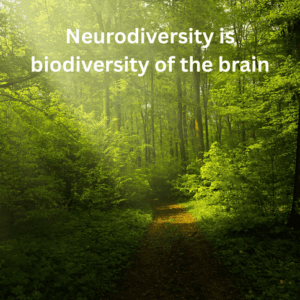
“I used to think there was something seriously wrong with me. Why couldn’t I do simple things like remember appointments, fall asleep at a reasonable hour, or stop zoning out in the middle of a conversation? I felt scattered, impulsive, too intense one minute and completely shut down the next. I kept trying to ‘fix’ myself—to be more organised, less sensitive, more normal—but nothing ever worked for long. It was exhausting.”
If you’ve ever felt like this, you’re not alone. Everyday struggles of neurodivergent people get labelled as symptoms. Many neurodivergent people are misjudged, misunderstood, and mislabelled. In this blog, we explore 12 commonly misread neurodivergent symptoms and explain what they may really be telling us. If you’ve been living with self-doubt or confusion about how your brain works, this blog may offer clarity, validation, and a new way forward.
What Is Meant by Neurodivergent Symptoms?
Neurodivergence refers to variations in brain function that affect how individuals think, feel, perceive, and interact with the world. Common forms of neurodivergence include ADHD, autism, dyspraxia, and dyslexia. The term ‘symptom’ is often used in medical contexts to describe these traits, but many neurodivergent advocates challenge this framing. While the Diagnostic and Statistical Manual of Mental Disorders (DSM-5) still relies heavily on a deficit model, lived experience tells a richer, more nuanced story—one where many so-called symptoms are adaptations, responses, or expressions of difference. Safety, context, and accurate understanding are essential in interpreting these traits.
The medical model frames neurodivergence as a set of clinically defined neurodivergent symptoms that often leads to stigma, misdiagnosis, and exclusion. In contrast, the bio-psycho-social-spiritual model sees these traits as part of a broader human experience. It considers biological makeup, psychological processes, social environment, and meaning-making systems.
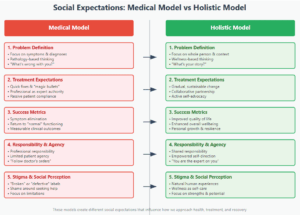
Neurodivergence is not a flaw or impairment—it is a natural and valuable variation in the human population. Just as biodiversity strengthens ecosystems, neurodiversity enriches society with different ways of thinking, creating, and problem-solving. Visit Neurodivergent insights to learn more about affirming approaches.
Table of Contents
- Executive Function Challenges
- Difficulty with Social Interactions
- Attention Issues
- Impulsivity
- Daydreaming
- Selective or Picky Eating
- Insomnia
- Sensory Sensitivities
- Emotional Intensity
- Hyperfixation
- Skin Picking
- Stimming
1. Executive Function Challenges
One of the most often cited so-called neurodivergent symptoms are executive function challenges. Linked to ADHD, Autism, and Dyspraxia, these challenges affect planning, time management, memory, and task initiation. Often mistaken for laziness or lack of discipline, executive dysfunction is really a neurological pattern. Stress, transitions, and unstructured environments can magnify it.
Many people blame themselves when they forget appointments or procrastinate, but this pattern is not about poor character—it’s about unmet support needs.
While executive function challenges can make everyday tasks harder to manage, many neurodivergent individuals develop creative, intuitive strategies for problem-solving, planning, and adapting—often seeing patterns and solutions others might miss.
2. Difficulty with Social Interactions
Autism and attention differences or ADHD often include challenges in reading social cues, sensory overwhelm in social spaces, or needing more processing time. These neurodivergent differences are frequently misread as coldness or disinterest.
In reality, many neurodivergent symptoms individuals deeply value connection but may struggle with the demands and expectations of conventional social communication.

Difficulties with social interaction often come from a deep need for authenticity and clear communication. Many neurodivergent individuals value meaningful connection over small talk, which can lead to more honest, loyal, and thoughtful relationships.
3. Attention Issues
Attention issues are linked with ADHD and autism. Rather than having a deficit of attention, many neurodivergent symptoms people have difficulty regulating it. This can show up as distractibility, hyperfocus, or hypofocus. The mind may lock onto one thing with intense clarity, or drift away entirely depending on emotional state, sensory input, or task relevance. Distractibility isn’t about lack of willpower—it’s the brain reacting to everything as equally urgent or interesting.
It’s not a failure to pay attention, but a different rhythm of attention altogether. Understanding this helps us create environments where focus can flow more naturally, rather than forcing it through shame or pressure. These fluctuations are often environment-sensitive and influenced by emotional state, sensory input, or task relevance.
Attention differences stem from rapid thought processing combined with reduced ability to pause and filter responses, generating both creative potential and behavioural challenges. Hypofocus—when attention drifts or shuts down—isn’t laziness; it’s often the brain’s way of protecting itself from overwhelm or lack of stimulation. Recognising this can lead to more compassionate strategies and space for gentle re-engagement when the time is right.
4. Impulsivity
Linked to ADHD, autism under stress, or Tourette’s, impulsivity is often misread as a behavioural problem. But it can be a way of managing overwhelm or processing quickly.
Impulsivity is also associated with spontaneity, creativity, and responsiveness—qualities that are often undervalued in rigid systems.
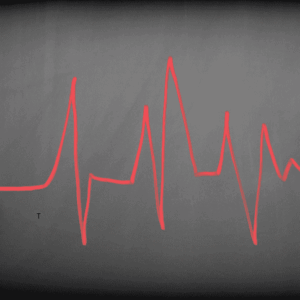
Impulsivity in neurodivergent people can fuel spontaneity, creativity, and bold decision-making. It often leads to fresh ideas, quick action, and the courage to take risks that others might overthink.
5. Daydreaming
Less often seen as a neurodivergent symptom and more as a lack of focus, daydreaming is often dismissed as unproductive and wasteful. But this behaviour may serve as a creative outlet, form of rest, or emotional escape.
When safe and supportive environments are introduced, daydreaming can be harnessed for imagination and insight rather than seen as a flaw.
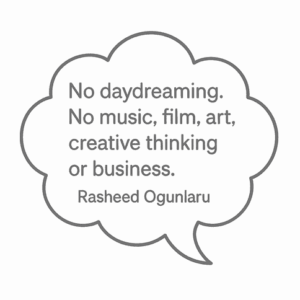
For many neurodivergent people, drifting into inner worlds isn’t a flaw—it’s a sign of a vivid mind seeking space, inspiration, or safety. As Rasheed Ogunlaru once said, “No daydreaming. No music, film, art, creative thinking or business.”
6. Selective or Picky Eating
Often linked to autism and Avoidant/Restrictive Food Intake Disorder (ARFID), this trait reflects sensory sensitivities around taste, texture, smell, and even temperature.
Judging or forcing changes can increase distress. Respecting and understanding eating preferences supports bodily autonomy and self-trust.
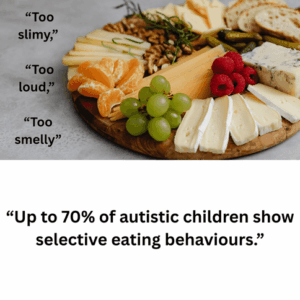
Selective eating is often a sign of deep sensory awareness and body intuition. Rather than being fussy, many neurodivergent symptoms individuals are simply attuned to what feels safe, manageable, and nourishing for their nervous systems.
7. Insomnia
Sleep difficulties are common in ADHD, autism, and anxiety. They may arise from sensory overload, mental overstimulation, or late-night decompression rituals.
Understanding individual sleep patterns can help create tailored routines and reduce shame or frustration.

Many neurodivergent symptoms come alive when the world quiets down—nighttime can be a space for creativity, reflection, or emotional processing. While insomnia can be tough, it also speaks to a unique rhythm that may thrive with flexibility and understanding, not rigid routines.
8. Sensory Sensitivities
Sensitivity to light, sound, texture, or temperature is a key trait of autism, ADHD, dyspraxia and sensory processing differences. Everyday stimuli can feel overwhelming, painful, or impossible to filter out. It is often seen as an overreaction.
In reality, it’s a different neurological threshold that can be supported with thoughtful accommodations, not suppression.
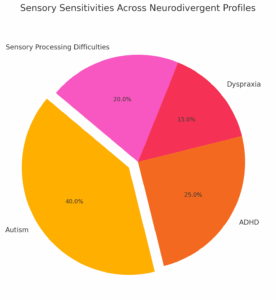
Common sensitivities include sound, texture, light, smell and touch. Discomfort with certain textures and clothing is also common. These can present as either hypersensitivity (over-responsiveness) or hyposensitivity (under-responsiveness).
9. Emotional Intensity
Emotional responses may be quicker, deeper, or longer lasting for many neurodivergent individuals. This is sometimes mistaken for instability.
But emotional intensity often reflects empathy, passion, and affinity. Learning emotional regulation within safe relationships is far more effective than suppression.
Telling someone they ‘feel too much’ dismisses the depth, empathy, and intuition that emotional sensitivity can bring. For many neurodivergent individuals, this intensity is not a weakness—it’s a powerful capacity for connection, insight, and emotional truth.
10. Hyperfixation
Often linked to both ADHD and autism, this paradox of being unable to start one task while deeply immersed in another is misunderstood.
Hyperfocus can produce astonishing depth of knowledge or creativity when nurtured, but may need external regulation to support balance.
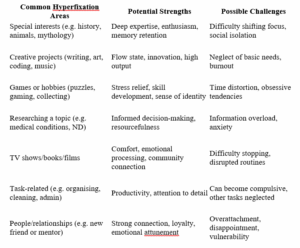
Hyperfocus can be a powerful gift—when something truly captures a neurodivergent person’s interest, they can enter a deep state of flow that allows for exceptional creativity, productivity, or learning. In these moments, distractions fade and meaningful progress becomes possible in ways that feel natural and energising.
11. Skin picking
Often linked to ADHD, autism, anxiety, and body-focused repetitive behaviours (BFRBs), skin picking is frequently misunderstood as a bad habit. In reality, it’s often a self-soothing or sensory-regulating response—especially during times of boredom, stress, or overstimulation.
While skin picking can cause distress or physical harm if unmanaged, it’s important to approach it with compassion. Supporting someone to find gentler, alternative coping strategies is far more effective than shaming the behaviour.
For many neurodivergent individuals, skin picking provides a sense of grounding, relief, or focus. Recognising this as a coping mechanism allows for more compassionate and supportive responses. Fidget toys offer a non-verbal, non-disruptive way to release anxiety or tension and can prevent escalation into more intense stimming behaviours.
12. Stimming
Short for “self-stimulatory behaviour,” stimming includes movements or sounds such as hand-flapping, rocking, humming, tapping, or using fidget tools. Stimming is commonly seen as one of the main symptoms in autism. In recent years, it has also been linked to ADHD and other neurodivergent symptoms. It helps regulate emotions, focus, or sensory input.
Stimming is often pathologised or discouraged—especially in public—but it serves an important function. When accepted and supported, stimming can reduce anxiety, prevent shutdowns or meltdowns, and foster self-regulation. It’s a form of expression, not a problem to be fixed.
Stimming is a natural way for many neurodivergent people to self-soothe, focus, and express emotion. Far from being something to suppress, it’s often a powerful tool for regulation, creativity, and feeling grounded in the body.
Bringing It All Together
Q&A
Q1: Is neurodivergence always visible?
No. Many people mask or compensate for their traits, especially in professional or social settings. This can lead to burnout and delayed diagnosis or symptoms.
Q2: Can you be neurodivergent without a formal diagnosis?
Yes. Self-identification is valid, particularly when diagnostic pathways are long, costly, or inaccessible. Many people recognise their traits through lived experience and community support.
Q3: Are these traits always a problem?
Not at all. Many so-called symptoms are only problematic when unsupported or judged. With the right environment, they can become neutral or even positive.
Q4: How can I know if I’m neurodivergent?
Start by exploring traits and patterns in your life, ideally with non-pathologising frameworks. Tools like self-checks and specialist consultations can help. Take our holistic self-assessment quiz.
Q5: What’s the danger of mislabelling these traits?
Misunderstood traits can lead to inappropriate interventions, internalised shame, and poor mental health. Reframing them can support healthier self-esteem and coping.
Q6: Can neurodivergent people thrive?
Absolutely. With awareness, adjustments, and supportive relationships, neurodivergent individuals can lead rich, meaningful, and successful lives.
Want to explore your own traits and how they affect your life? Visit us to learn more about our holistic trait assessments and personalised support options. Clarity and understanding await—and with them, a stronger, more confident you.